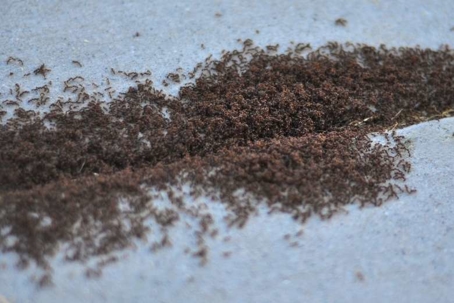What Do Pavement Ants Eat?
Pavement ants are opportunistic foragers and have a highly varied diet. These ants primarily consume:
Sugars and sweet substances – They are especially attracted to honeydew produced by aphids, plant nectars, syrups, sugary foods, and other carbohydrates.
Proteins – They feed on dead insects, meat scraps, and other protein-rich foods to support colony growth.
Fats – Oils, greasy foods, and fatty substances are also consumed when available.
Household foods – In human environments, pavement ants often invade kitchens and pantries, eating cereal, pet food, baked goods, and any accessible crumbs or spills.
Miscellaneous – They can also feed on fungi, seeds, and small arthropods when other resources are limited.
They are highly adaptable and will exploit nearly any food source that is accessible. Their foraging trails often extend from nesting sites in soil, under pavement, or in cracks near buildings, which allows them to efficiently locate both indoor and outdoor food sources.
Do Pavement Ants Eat Insects?
Pavement ants are opportunistic predators and scavengers, so when it comes to other insects, they primarily target:
Dead or injured insects – They will scavenge on any dead insects they encounter, including flies, beetles, caterpillars, and other small arthropods.
Soft-bodied insects – Aphids, small caterpillars, and other soft-bodied insects are eaten if available, though pavement ants often farm aphids for honeydew rather than consuming them directly.
Small arthropods – Mites, springtails, and other tiny invertebrates can be part of their diet.
Nest raiding or competition – Occasionally, they may attack other ant species’ brood or other small insect colonies if there’s an easy opportunity, taking larvae or pupae as protein sources.
Their insect diet is mostly opportunistic and supplemental—proteins from insects help the colony grow, but they rely heavily on sugary foods and honeydew for energy.
Do Pavement Ants Eat Animals?
Pavement ants are small, opportunistic feeders, so their diet of animals is limited to what they can overpower, scavenge, or transport back to the colony. The types of non-insect animals they are most likely to consume include:
Arachnids – Small spiders and mites can occasionally be taken if found, particularly if they are trapped or dead.
Other ant brood – Pavement ants may raid the nests of other ant species to eat eggs, larvae, or pupae.
Small invertebrates – Tiny worms, springtails, and similar soil-dwelling creatures can also be eaten when available.
Scavenged animal matter – Pieces of dead animals, such as small lizards, amphibians, or mammals too small or decomposed for larger predators, can be scavenged if accessible.
Pavement ants are not predators of large animals—they focus on very small creatures or carrion that can be transported or consumed in parts. Protein from these sources supplements the carbohydrates they get from sugars and honeydew.
Do Pavement Ants Eat Plants?
Pavement ants are not strict herbivores, but they do interact with plants primarily for the sugars and nectars they provide. The types of plant material they are most likely to consume include:
Plant nectars and exudates – Flowers producing nectar are attractive, and any plant sap leaking from damage can be a food source.
Honeydew-producing insects on plants – While not a direct plant consumption, pavement ants tend and “farm” aphids and other sap-sucking insects on plants to harvest the honeydew. This often drives their activity on garden plants, shrubs, and even lawn grasses.
Seeds and small fruits – They may collect tiny seeds, berries, or fallen fruit that are soft or easily broken down.
Soft plant tissues – Occasionally, tender leaves, petals, or other plant parts can be chewed or harvested, usually when other food sources are scarce.
Root exudates – Pavement ants sometimes forage near the soil surface for sweet root secretions or decaying plant matter in cracks and under pavements.
Pavement ants are attracted to sugar-rich plant resources rather than consuming large quantities of actual plant tissue. Their plant interactions are usually indirect, via honeydew or fallen seeds, rather than active herbivory.

